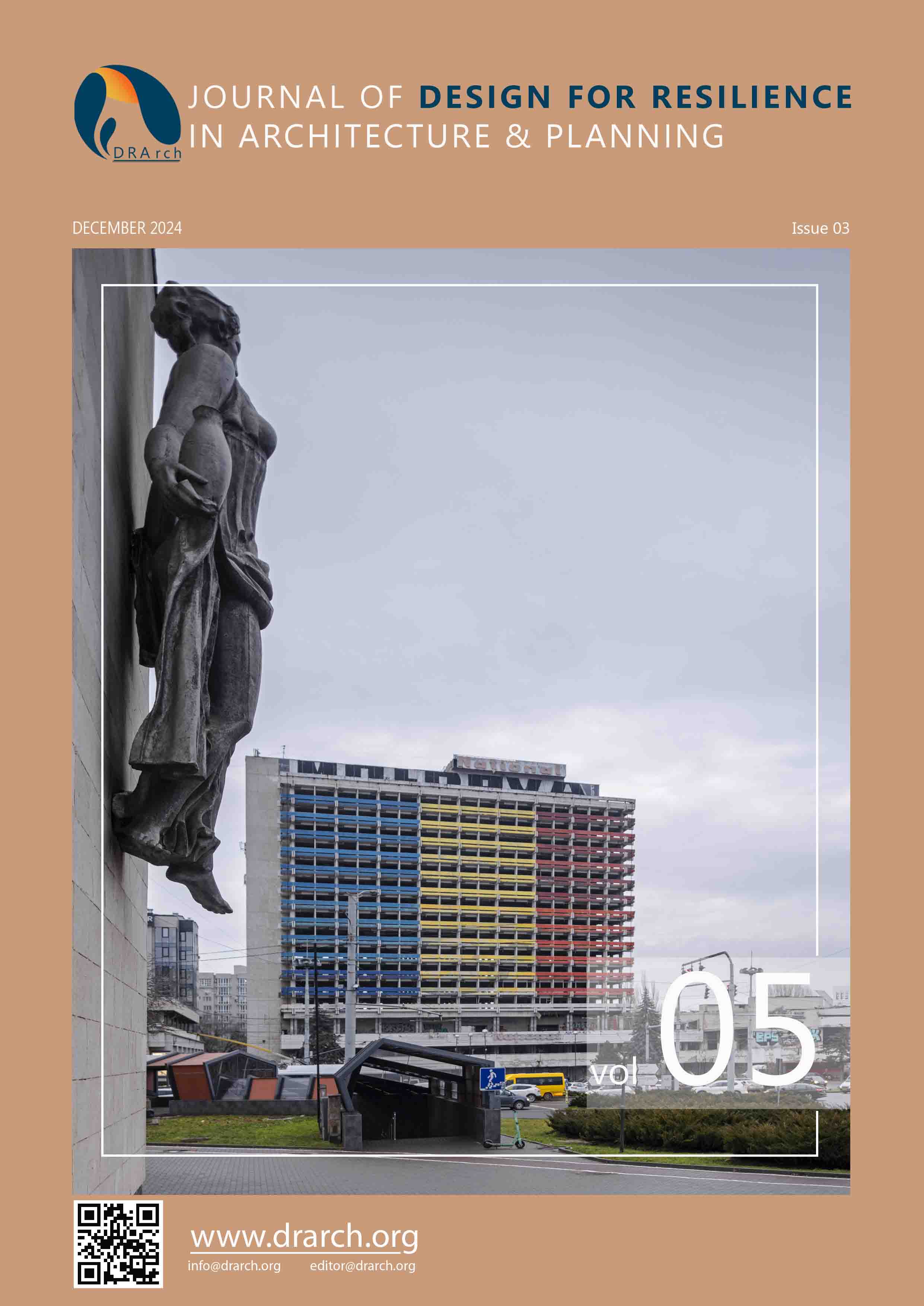Flexible Model Proposals for Post-Disaster Temporary Housing in Architectural Design
DOI:
https://doi.org/10.47818/DRArch.2024.v5i3145Keywords:
architectural design education, container, earthquake, flexible design, portable designAbstract
Shelter is one of the most basic needs that emerged with the existence of humanity and is necessary for people to continue their lives. In addition to meeting physical needs, it also has social and cultural functions. Especially in the post-disaster process, it is essential to create temporary shelter units in the face of emerging problems. Since societies can be affected simultaneously in this process, needs must be met as quickly as possible. "Flexible container designs" are seen as a solution to this problem. Flexible container designs can provide significant advantages in meeting basic needs after a disaster and in terms of rapid intervention. The study aims to present flexible model suggestions that can be used to produce temporary shelter units. Because the production of temporary shelter units is essential in terms of flexibility due to reasons such as reusability, portability, limited design periods, etc. The study discusses the designs made by the students within the scope of the Structural System Information course of the Architecture Department of Gazi University Faculty of Architecture. The students were asked to produce solutions to problems such as the emergence of shelter needs for people after disasters, bringing containers to the need area, and serving different functions. The study reveals the value of the concepts of flexibility, portability, and modularity in the design of temporary shelter units through student designs; it emphasizes the importance of these concepts in design processes in both architectural education and architectural practices. The study will contribute to the development of innovative, flexible, and portable solutions.
Downloads
References
Abanoz, F. B., & Vural, N. (2023). Dünyada ve Türkiye’de kullanılan geçici afet konutlarının karşılaştırmalı analizi ve model önerisi, Eksen Dokuz Eylül Üniversitesi Mimarlık Fakültesi Dergisi, 4(1), 132-153.
AFAD, (2015). Geçici barınma merkezlerinin kurulması, yönetimi ve işletilmesi hakkında yönerge. https://www.afad.gov.tr/yonerge
AFAD Deprem Konteyneri-Konteyner Kent. (2024). Prefabrik-karmod prefabrik. https://www.karmod.com/konteyner/afet-sonrasi-acil-barinma-unitesi/
Avlar, E., Limoncu, S., & Tızman, D. (2023). Deprem sonrası geçici barınma birimi: CLT E-BOX. Gazi Üniversitesi Mühendislik Mimarlık Fakültesi Dergisi, 38(1), 471-482. https://doi.org/10.17341/gazimmfd.1027894
Beyatlı, C. (2010). Acil durum barınakları ve bir barınak olarak acil durum konteynır öneri modeli. Yüksek Lisans Tezi, Trakya Üniversitesi Fen Bilimleri Enstitüsü, Edirne.
Clarivate. (2024). Clarivate. https://www.webofknowledge.com/
Erdoğan Biter, Y. (2023). Afet yönetiminde kullanılabilir acil durum modülü için hızlı-kolay-tekrarlanabilir bir kurulum modeli geliştirilmesi ve hizmet alt yapısının kurgulanması. Doktora Tezi, Mimar Sinan Güzel Sanatlar Üniversitesi Fen Bilimleri Enstitüsü, İstanbul.
Félix, D., Branco, J. M., & Feio, A. (2013). Temporary housing after disasters: A state of the art survey. Habitat International, 40, 136-141. https://doi.org/10.1016/j.habitatint.2013.03.006
İnan, N. (2014). Kinetik yapı tasarımında işlevsel esneklik ve entegre sistemlerin kullanım önerisi. Doktora Tezi, Gazi Üniversitesi Fen Bilimleri Enstitüsü, Ankara.
Kumaş, B. (2022). Konteynerların geçici konut olarak kullanımı ve mekansal çözüm önerileri geliştirilmesi. Yüksek Lisans Tezi İstanbul Üniversitesi Lisansüstü Eğitim Enstitüsü, İstanbul.
Maral, H. (2016). Afet sonrası geçici yerleşim yerlerinin planlanmasında üst ölçekli planlama: Karşıyaka örneği. Yüksek Lisans Tezi, Gediz Üniversitesi, Fen Bilimleri Enstitüsü, İzmir.
Niu, G. (2010). New container architecture: Design and sustainability. Laurence King Publishing.
Radev, S. (2017). Flexible architecture: Modularity, portability and prefabrication. Routledge.
Tapan, M. (1972). Prefabrike elemanlarla yapımda esneklik veya değişkenlik sorunu. YAK Bülteni, İTÜ Mimarlık Fakültesi, İstanbul.
The Sphere Handbook. (2018). Humanitarian charter and minimum standards in humanitarian response. https://spherestandards.org/
Vural Arslan, T. & Gülay, M. (2023). Afet sonrası geçici barınma alanları tasarımı. Kentli Dergisi, 49, 78-85.
Wagemann, E. (2017). From shelter to home: Flexibility in post-disaster accommodation. Doctoral Thesis, University of Cambridge, USA.
Yücel, S., & Aydınlı, S. (2015). ‘Mimarın eğitimi’ üzerine spekülatif bir deneme. Erciyes Üniversitesi Fen Bilimleri Enstitüsü Dergisi, 31(1), 17-23.
Zenter, Ö. (2018). Kinetik biyomimetik yaklaşımların mimari tasarımda işlevsel esneklik amaçlı kullanılması. Yüksek Lisans Tezi, Gazi Üniversitesi Fen Bilimleri Enstitüsü, Ankara.
Downloads
Published
Issue
Section
License
Copyright (c) 2024 Mazlum Kalak, Ozge Zenter, Emine Fulya Özmen

This work is licensed under a Creative Commons Attribution 4.0 International License.








